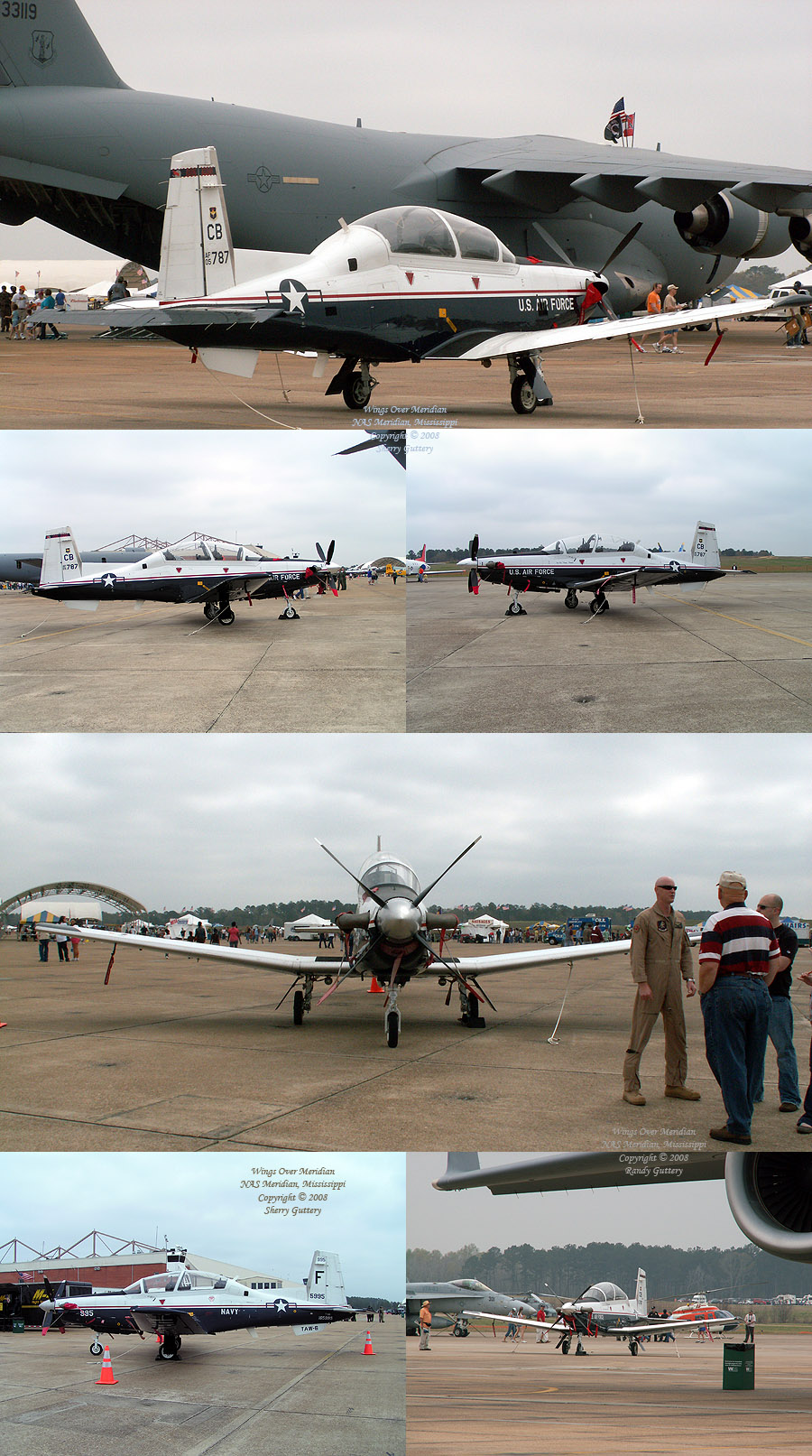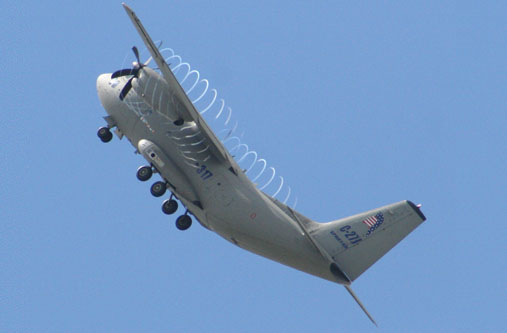Glimpses of Meridian, Mississippi |
|||||||
Wings Over Meridan
|
|||||||
|
|
|||||||
| Meridian is unusual compared to most small towns - it's regional air port has the state's longest commercial runway - and has a busy civil aviation business - built on the heritage of the Key Brothers' accomplishments and contributions to the aerospace industry. Adding to the activities at the air port are several Mississippi National Guard units - including: Mississippi Air National Guard186th Refueling Wing - which flies a fleet of Boeing KC-135R Stratotankers - and includes two subordinate commands : 248th Air Traffic Control Squadron, Key Field ANGB, Meridian, MS. The squadron trains, equips and maintains combat ready Air Traffic Control and Landing System professionals for rapid deployment and employment worldwide Mississippi Army National Guard's 185th Army Aviation Support Facility, who flies a fleet of CH-47 Chinook heavy-lift helicopters. |
|||||||
|
|
|||||||
Meridian's "other" airport:
Naval Air StationMeridian, MSHome of Jet Strike Pilot Training -
| |||||||
| There are only two bases in the world that provide the finest in Carrier based Jet Strike Pilot training - and Meridian, MS is home to one of them. Located on roughly 8,000 acres approximately 11 miles north of Meridian, NAS Meridian trains more than 160 carrier-qualified pilots a year (both Navy and Marine - and occasionally officers from allied nations as well). In addition - NAS has other training facilities including Naval Technical Training Center (NTTC) - which is the Navy's primary training facility for enlisted administrative and supply class "A" schools. The G. V. "Sonny" Montgomery Navy Operational Support Center and training unit (U. S. Naval Reserves) - trains Naval Reservists in the latest support techniques and community service response. Together - these schools train more than 5000 students a year. About 500 sailors are receiving their primary technical job training at NAS Meridian at any given time. One additional training facility at NAS is the Regional Counterdrug Training Academy with the mission to provide no-cost, "street level," case-making, counterdrug skills to civilian law enforcement officers. This is part of the Navy's efforts to "give back" to the communities that support the Navy. It should also be noted that the local Navy League has one of the highest memberships of any comparable League that is "land based" (rather than port based). And yes - this is "THAT BASE!!!!" the only base to have been "at risk" in every round of BRAC - and survived. As noted - the Navy "gives back" to the community - the RCTA being one thing - then there's the huge support for things like the Special Olympics; Habitat for Humanity - blood drives; and the list goes on. |
|||||||
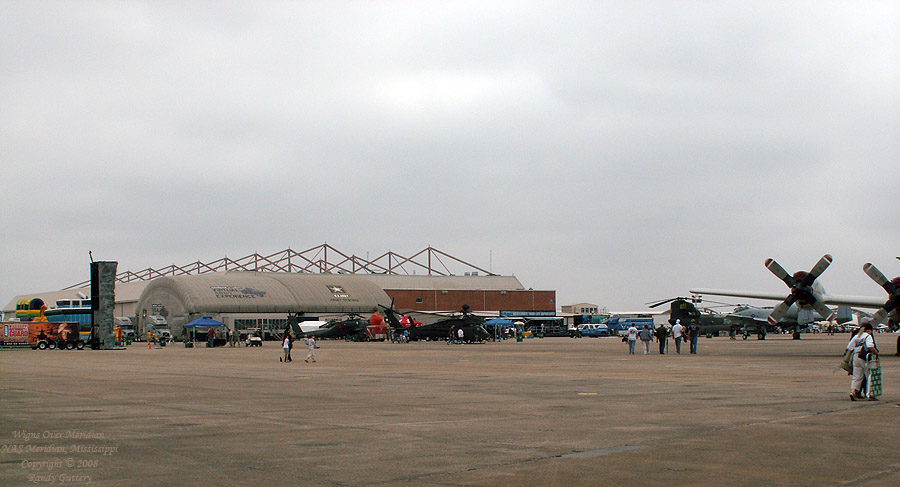 |
|||||||
| The south runway is turned into a giant parking lot for people attending the show; as you make your way onto the huge south tarmac - the hanger and shop facilities come into view. This is where the "static displays" are available for "up close and personal inspection". | |||||||
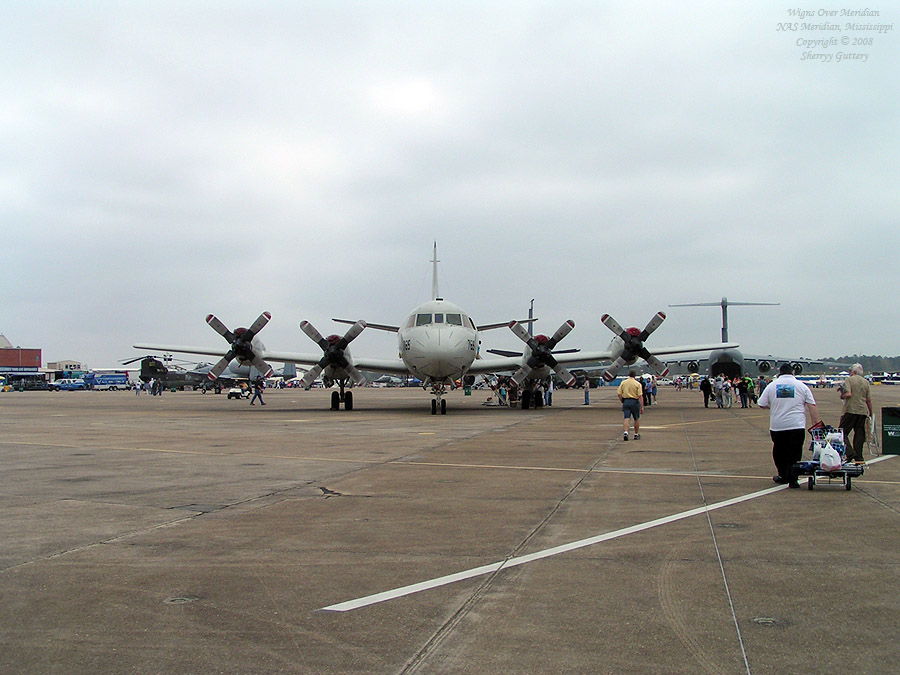 |
|||||||
| Scanning clock-wise - the first aircraft on display is a Navy P-3C "Orion". | |||||||
 |
|||||||
| Continuing clock-wise several smaller planes... | |||||||
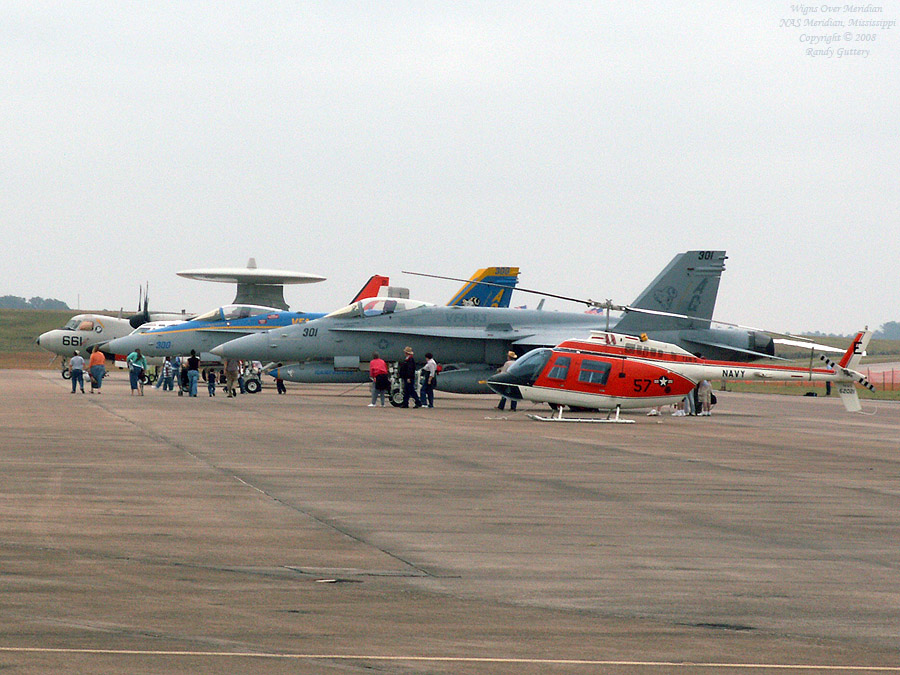 |
|||||||
| and a Navy rescue chopper. | |||||||
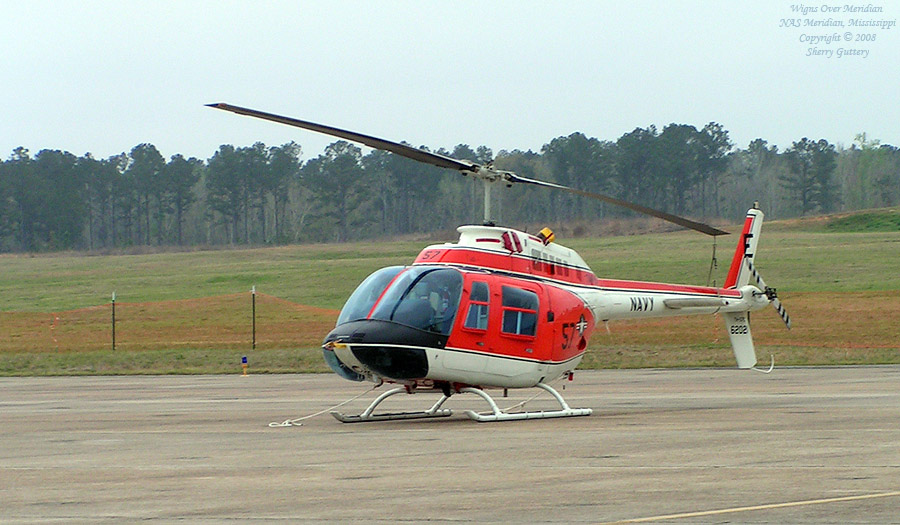 |
|||||||
| This Huey is a fairly common site around Meridian skies - fulfilling it role in Search and Rescue missions 24/7. | |||||||
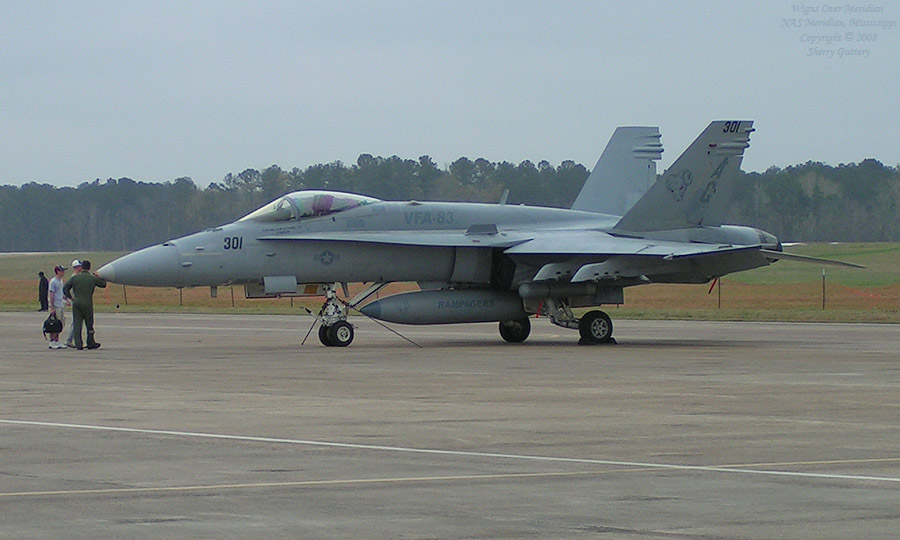 |
|||||||
| One of the fastest and toughest multi-mission carrier based strike jets in the world, this FA-18C Hornet is in "working clothes". Though perhaps not as "handsome" as it's Blue Angels siblings, this one is ready to go to work protecting the interests of our country. VFA-83 "Rampagers" group flies out of Naval Air Station Oceana, Virginia Beach, VA - our U.S. Navy "Master Jet Base" on the east coast. During Operation Desert Storm - there were several instances where FA-18C Hornets would encounter hostile enemy planes, shoot them down, then continue on to complete their assigned bombing mission. | |||||||
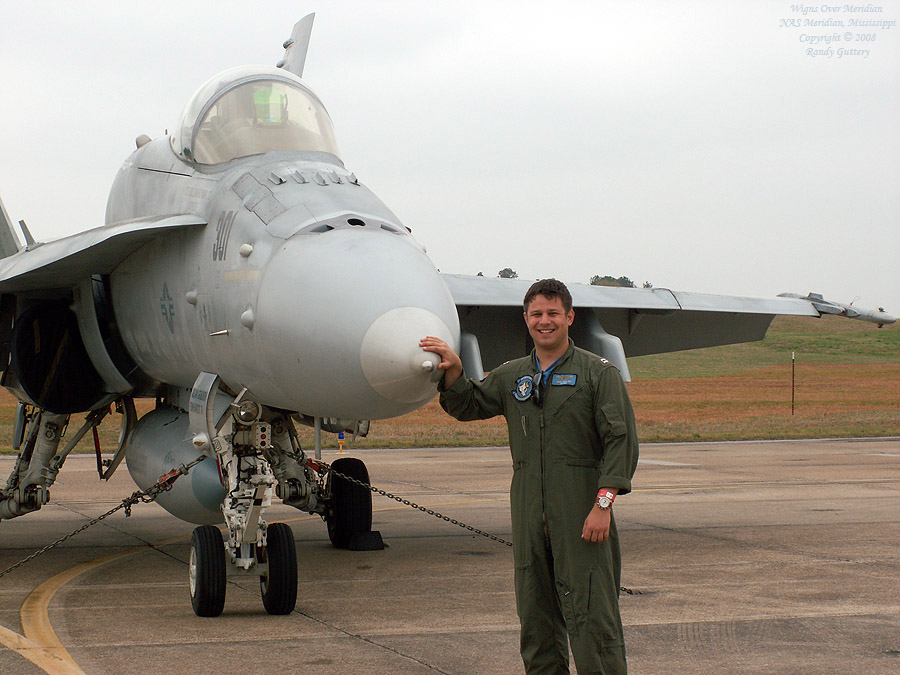 |
|||||||
| This Hornet's pilot. Nice, friendly guy - unless you're a bad guy - then he becomes your worst nightmare - at nearly 1200 miles per hour - it's hard to get away from him... |
|||||||
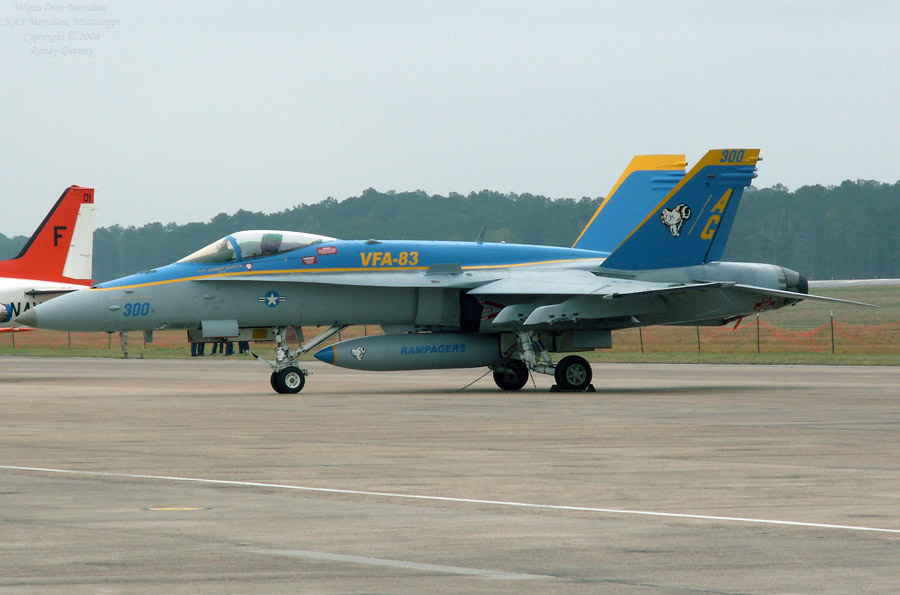 |
|||||||
| Here's a "Rampagers" FA-18C in Dress Blues. | |||||||
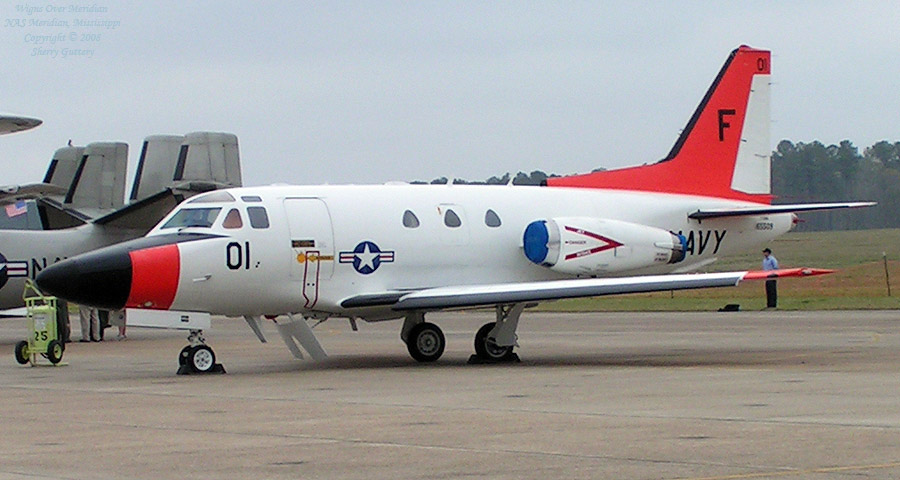 |
|||||||
| North American "Saberliner" is an interesting plane - an older design - yet quite capable. 500+ knots, and 40,000ft.+ service ceiling can get you from here to there quite quickly. However - both the Air Force and Navy recognized another role - and when in military attire - the Saberliner becomes the T-39 Trainer. Used for both RADAR and Navigation training for jet pilots - this flying classroom gives "real world" experience that just can't be done on the ground. T-39s are seen around Meridian - as both NAS Meridian and Columbus Air Force Base like to use Meridian Regional Air Port for approach and departure training. Columbus Air Force Base, located at Columbus, Mississippi - is one of the Air Force's "Jet Strike Pilot Training" bases. Yes - Mississippi graduates a significant number of all U.S. Jet Strike trained pilots. Mississippi? Believe it! | |||||||
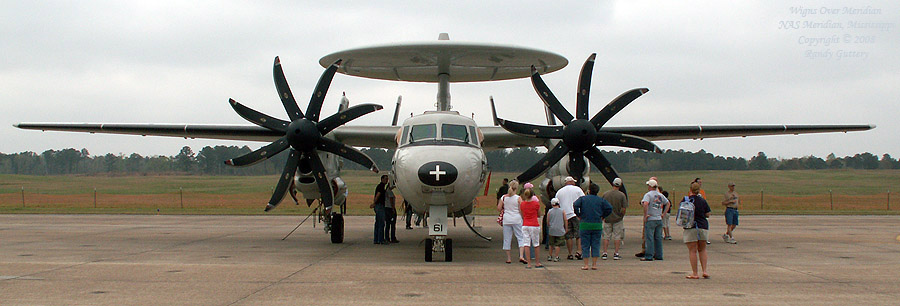 |
|||||||
| The E-2C "Hawkeye" - and "eye" it indeed is. This workhorse is the "eyes and ears" of the carrier fleet. | |||||||
 |
|||||||
| This plane has been retrofitted with the new NP2000 propellers - which are said provide many improvements over the old style propellers. Regardless - they certainly look cool! | |||||||
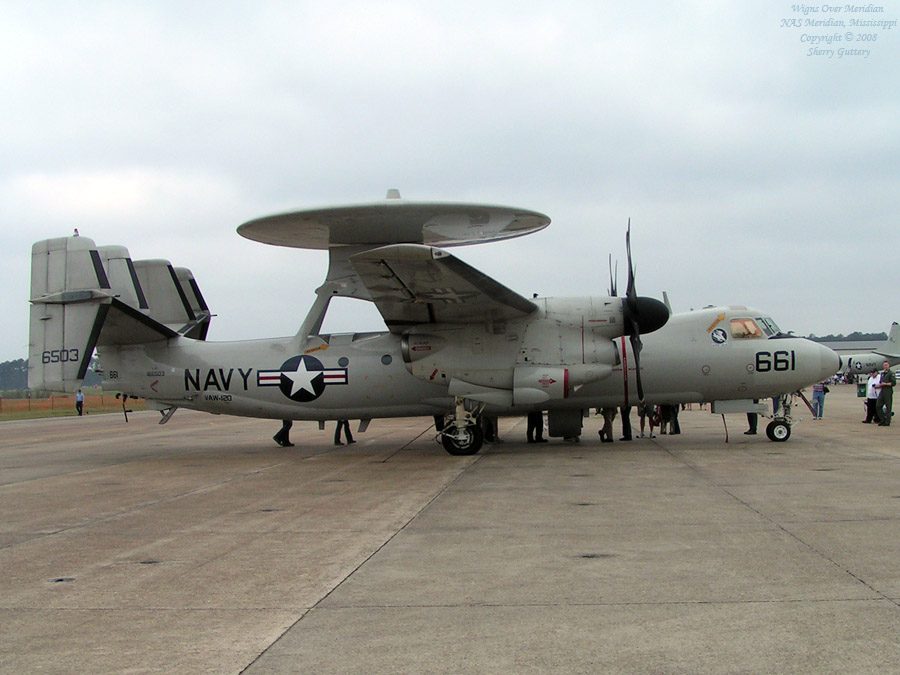 |
|||||||
| Here one gets a good view of one of the twin Rolls Royce T56-A-427 engines - each one producing some 5,100shp (Shaft horse power - being a turbo-prop). | |||||||
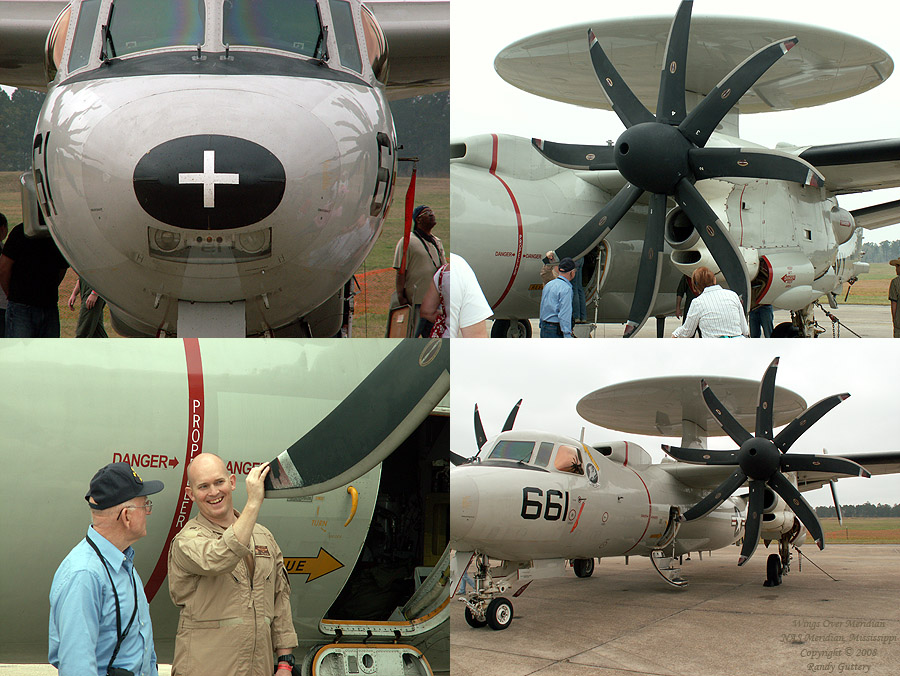 |
|||||||
| Some "up close and personal" views of the Navy's E-2C "Hawkeye" RADAR plane - the "eyes" of the carrier fleet. | |||||||
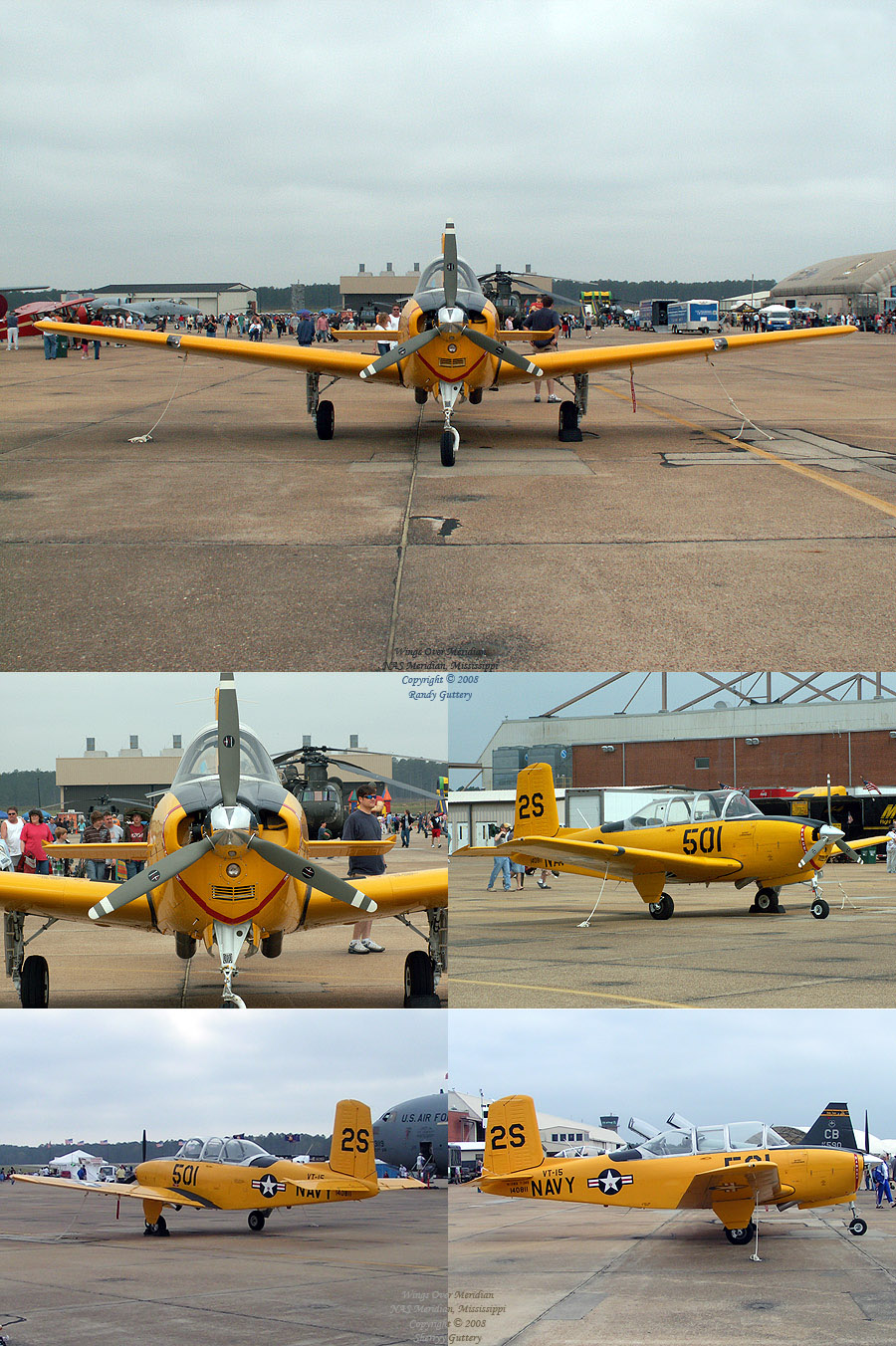 |
|||||||
| T-34C "Mentor" built by Beechcraft - derived from their famous Model 35 Bonanza; is a training air craft that serves as one of the "stepping stones" between "puddle hoppers" to more sophisticated flying machines in the making of Jet Strike Pilots. The early T-34Cs were piston driven - while the later versions were powered by a Pratt & Whitney turbine engine. | |||||||
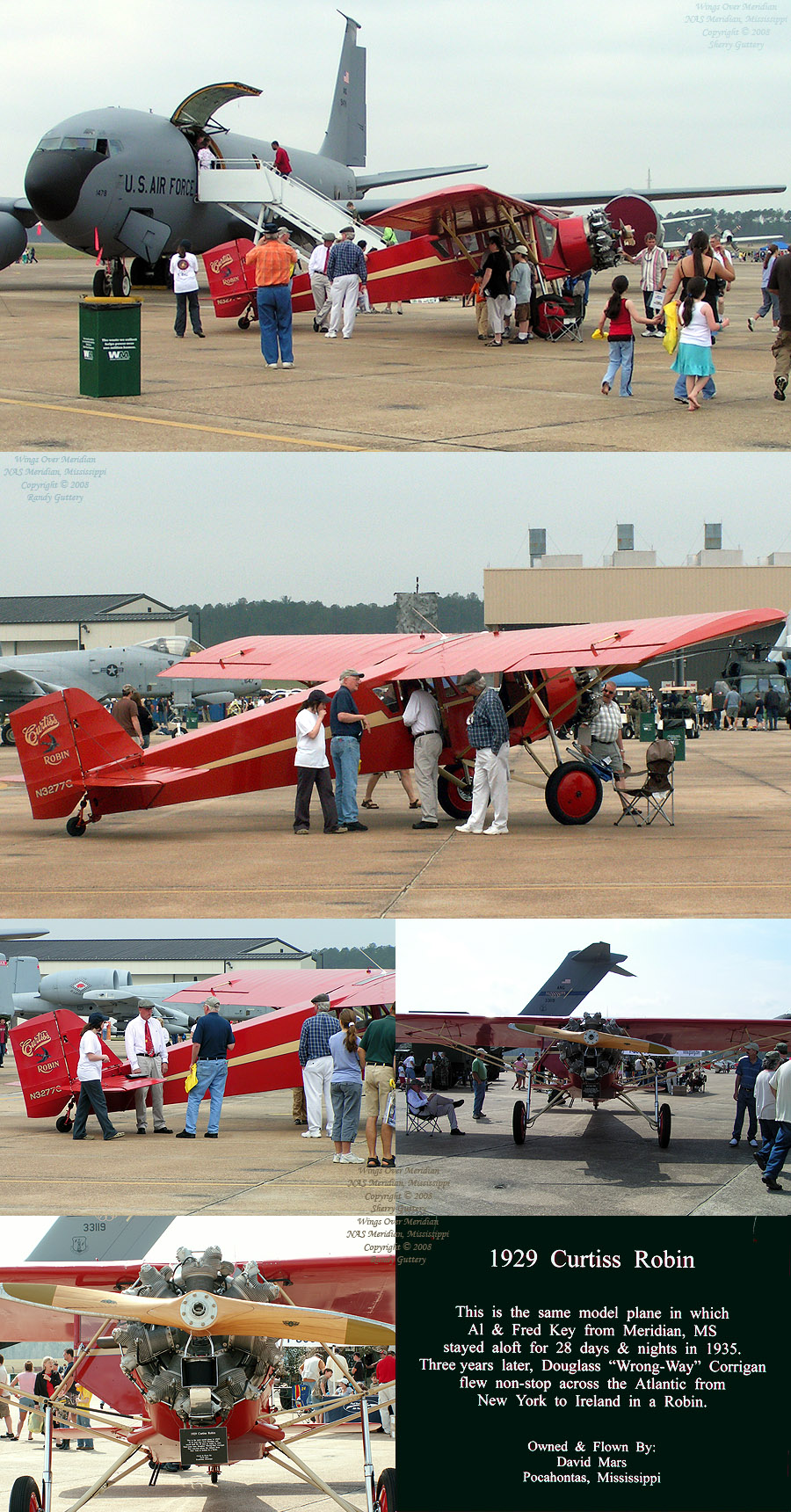 |
|||||||
| The sign pretty much tells the story: since "Ole Miss" - the plane the Key brothers set the record in is on display at the Smithsonian's National Air and Space Museum - this 1929 Curtis Robin is maintained, flown and displayed by David Mars of Pocahontas, Mississippi to share with people the history and contributions made by the Key Brothers - and their efforts in Meridian, MS to further the fledgling aero industry. | |||||||
| If you don't look closely - you might not realize the plane featured above is actually two planes - one "dressed" in Air Force attire - the other in Navy attire. Another "trainer" aircraft with a long history with both services in training Jet Strike pilots - the T-6A "Texan II" is the military version of Raytheon's Beech/Pilatus PC-9 Mk II. The T-6A has a Pratt & Whitney Canada PT6A-68 turbo-prop engine that delivers 1,100 horsepower. Because of its excellent thrust-to-weight ratio, the aircraft can perform an initial climb of 3,100 feet per minute and can reach 18,000 feet in less than six minutes. The aircraft is fully aerobatic and features a pressurized cockpit with an anti-G system, ejection seat and an advanced avionics package. This plane is another "step" in a student pilot's training. | |||||||
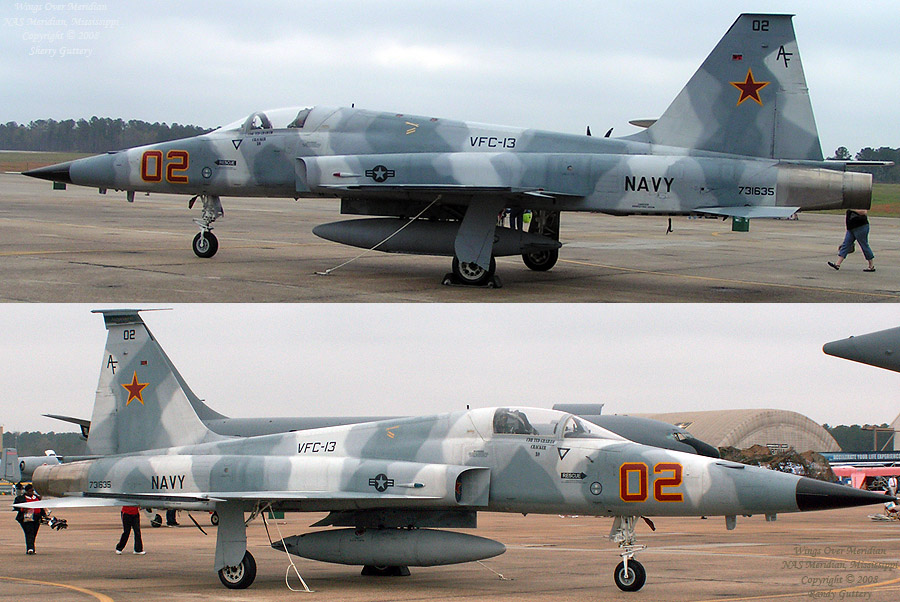 |
|||||||
| Going beyond "Jet Strike Pilot training" to the maximum extreme is the Navy's "Naval Fighter Weapons School", better known as "TOPGUN" flight training program. This Northrup F-5e "Tiger II" fills the role of the "aggressor" as a member of the "VFC-13 "Saints" aggressor squadron. Training at TOPGUN is designed to take the "Best of the Best" and hone their skills with practice and engagements that under another circumstance - could only be gained through actual combat - where mistakes are fatal - rather than just embarrassing. This airplane - is serving to save Naval Aviator's lives in a very real way. | |||||||
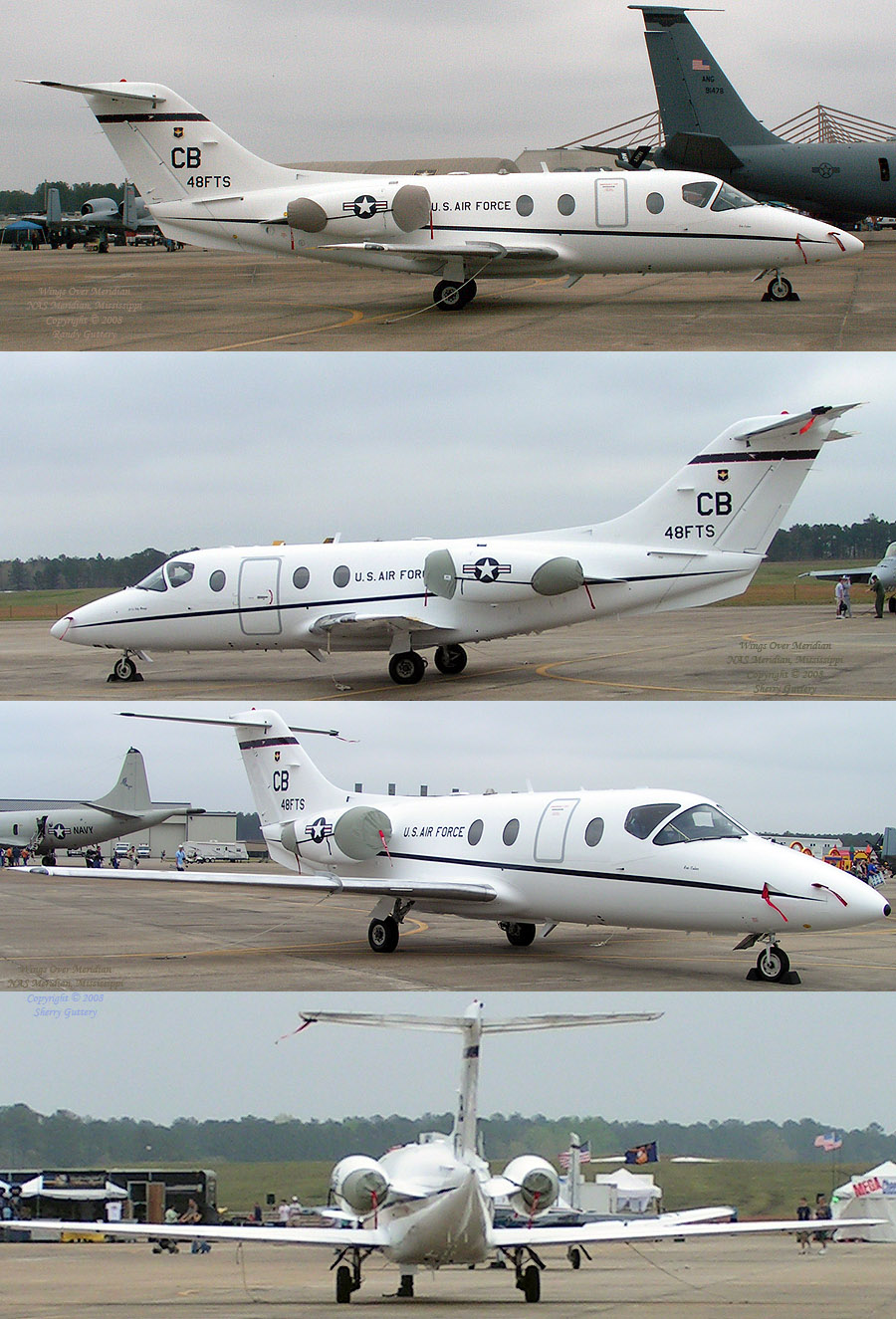 |
|||||||
| Developed from Beech's 400A - the Air Force's T-1A Jayhawk is a medium-range, twin-engine jet trainer. It is used by the US Air Force's Air Education and Training Command at Columbus Air Force Base (and other training bases) to train student pilots to fly airlift or tanker aircraft. | |||||||
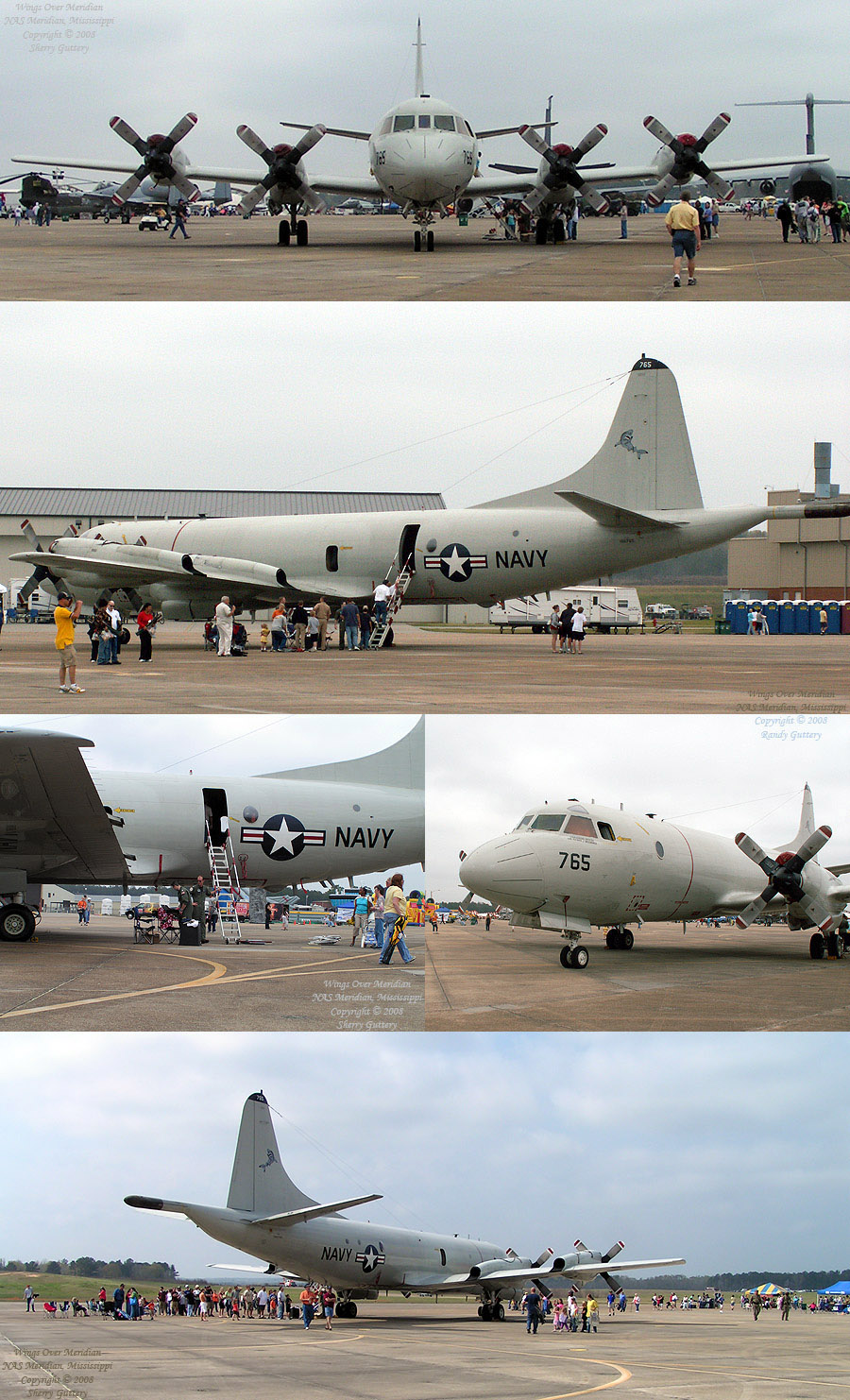 |
|||||||
| We came in this way - and in fact if you look at the picture immediately above - towards the right - you can see the entry point for people coming into the show area from the parking lot (south runway) - which can be seen just short of the tree line in the distance to the right. The P-3C "Orion" is an interesting aircraft - it is used by many, many agencies besides the military - including NASA, NOAA, US Customs and the CIA among them. This P-3C is a submarine hunter / killer. That long extension out the tail is the tip-off - as it houses the "magnetic anomaly detector" which detects a submarine's presence under water by the way the metal of the submarine's hull distorts the earth's magnetic field. The Orion is also equipped with a vast array of sensors - including several types of sonobuoys which can be launched from both pre-loaded outside launchers - as well as internal launchers which can accommodate launching the most appropriate sonobuoy as the sensor operators need. There is also an infra red and optics turret which allows line of sight tracking; various RADAR and other electronic sense and tracking devices. Once a target has been detected and determined to be hostile - the P-3C can provide an appropriate response from it's internal bomb bay under the front fuselage which can house conventional and, or special (nuclear) weapons, as well as underwing pylons, which can carry various armament configurations including AGM-84 Harpoon, AGM-65 Maverick, MK-50 Barracuda, MK-46 torpedo, precision surface attack AGM-12 Bullpup guided missile, 5 in (12.7cm)Zunni, and various other mines, missiles, and gravity bombs - everything from a warning "shot" to vaporization. The NOAA version of the Orion is outfitted as a research and hurricane hunting/wall busting; while a private company has converted 8 Orions into tankers - which are now used under contract to the US Forestry Service for firefighting service. Now in their 46th year of "service" with the US Navy- and not scheduled to be replaced until 2010-2013 - the P-3C Orion has proven to be an extremely versatile and dependable craft. |
|||||||
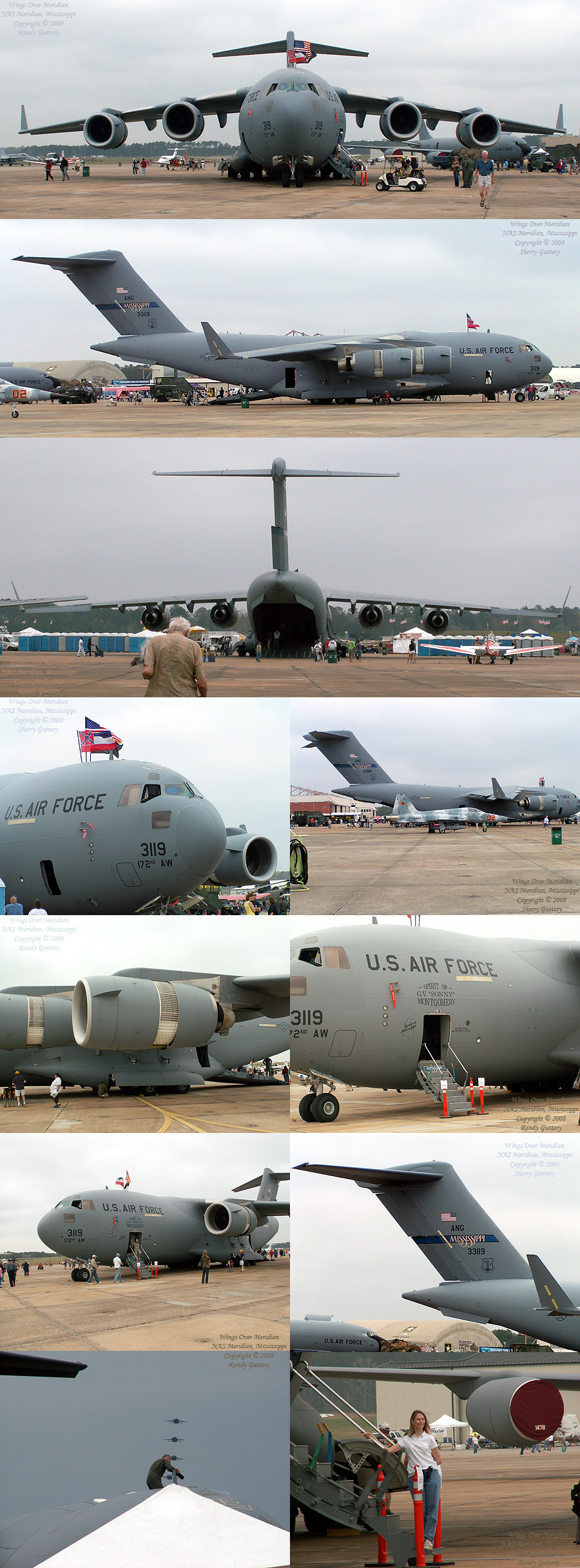 |
|||||||
|
|
|||||||
 |
|||||||
As we've noted many times before - Meridian, MS is the where in-flight refueling was invented. Meridian, MS still has an important role in such matters - as it's Key Field is home to the 186th Air National Guard - and their fleet of KC-135R tankers. A common sight around here (they literally fly over this house from time to time - of course being just 4 miles from the airfield- not surprising)- yet they are so common - they are hardly noticed. Their GE F-108 engines aren't very loud - particularly considering the 80,000+ pounds of thrust they generate. Full fuel load is some 30,000 gallons (200,000 pounds); and most can carry an additional 83,000 pounds of "other" cargo - which means plenty of room for the crew's luggage when deployed "over there". And over there can - and often is - anywhere in the world - the 186th often has planes deployed in support of operations in both Afghanistan and Iraq, and "other" places where the US military and allies are needing in-flight fuel.
|
|||||||
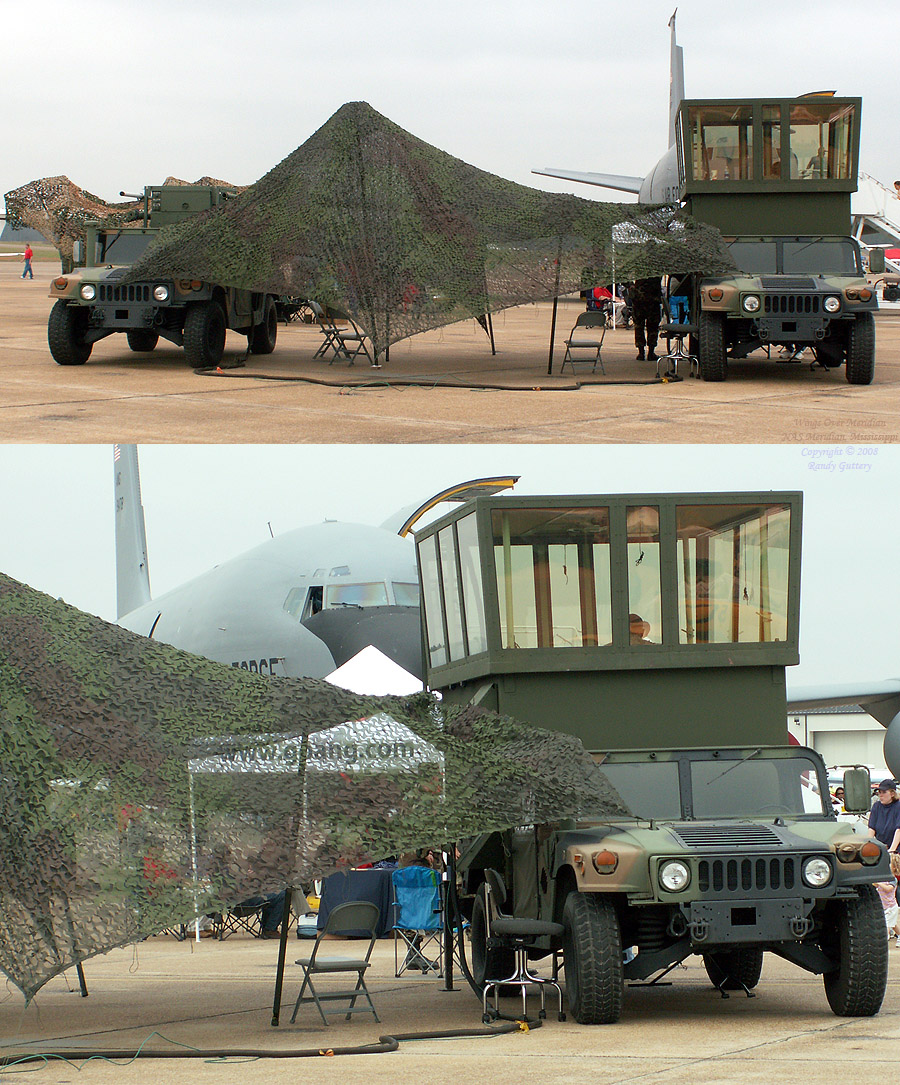 |
|||||||
| The Mississippi Air National Guard's 186th Air Wing's 248th Air Traffic Control Squadron. As a part of the 186th's mission - the 248th has complete Air Traffic control systems that can be delivered to any part of the world, set up and be fully functional in 24 hours or less. They maintain and operate all needed air traffic control equipment including a Mobile Tower , Mobile Radar and Mobile TACAN. Also part of the 186th (though not shown here) is the 238th Air Support Operations Squadron - whose mission is to provide the interface between the Army units it supports and the Air Force units that provide combat air support. The squadron advises the ground commander on the capabilities and limitations of combat aircraft weapons and assists in planning for combat air support. Since becoming fully operational in 2003, the 238th has participated in Operations Enduring and Iraqi Freedom as well as numerous joint services exercises. In addition to elements that make up the wing and tenant units at Key Field, the 186th is home to the Regional Operations and Security Center , a National Guard Bureau center that maintains a classified and unclassified wide area data network and houses some 50 DOD information systems for 15 flying units and 51 units across 11 states and territories. The 186th also operates one of only five state-of-the-art full-motion KC-135R flight simulators in the Air Reserve Component. Hundreds of Aircrew members from the Air National Guard, Air Force Reserve Command, and Active Duty Air Force train at Key Field each year to refine their flying skills in a controlled environment. | |||||||
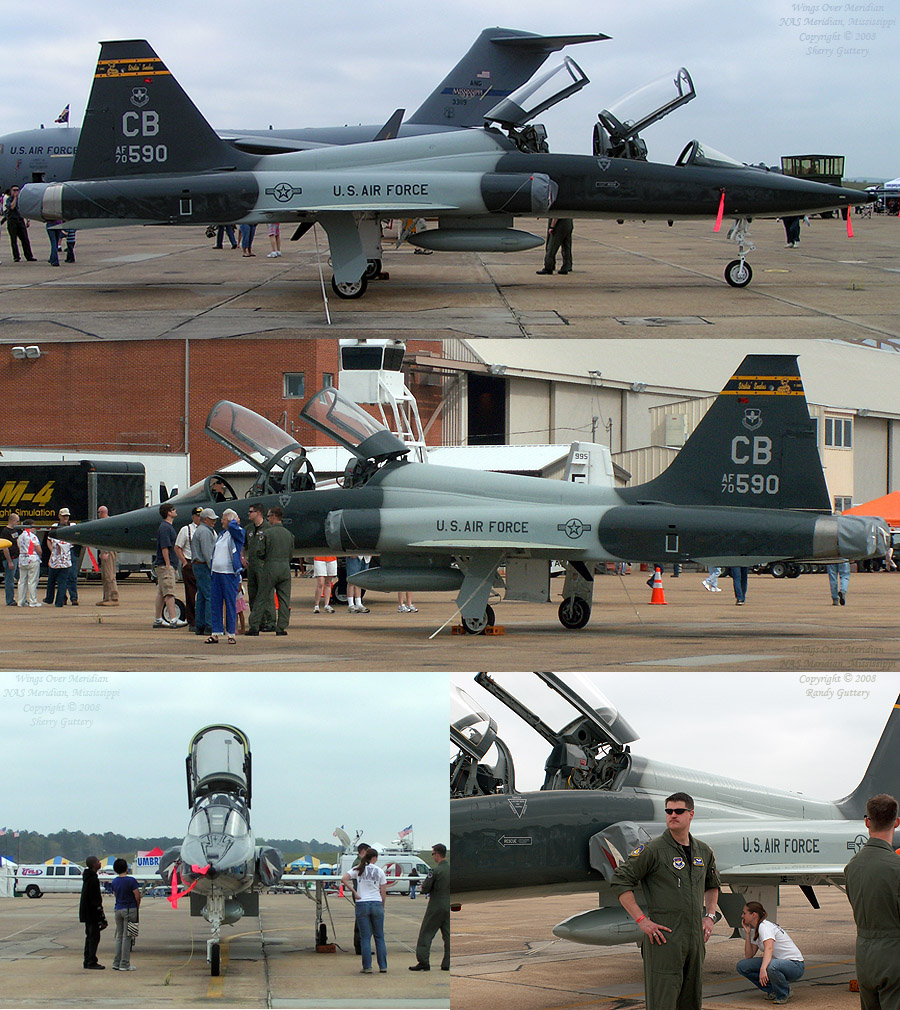 |
|||||||
| This is the Air Force's T-38C "Talon" - the worlds first supersonic jet trainer. In spite of having been in service since 1961 - and having trained more than 60,000 pilots - the Talon - through the "C" upgrade is expected to serve until 2020. The "C" upgrade includes a full "glass" cockpit - which better prepares the trainee for the F-15E Strike Eagle, F-15C Eagle, F-16 Fighting Falcon, B-1B Lancer, A-10 Warthog and F/A-22 Raptor which many will be assigned to fly during their career. | |||||||
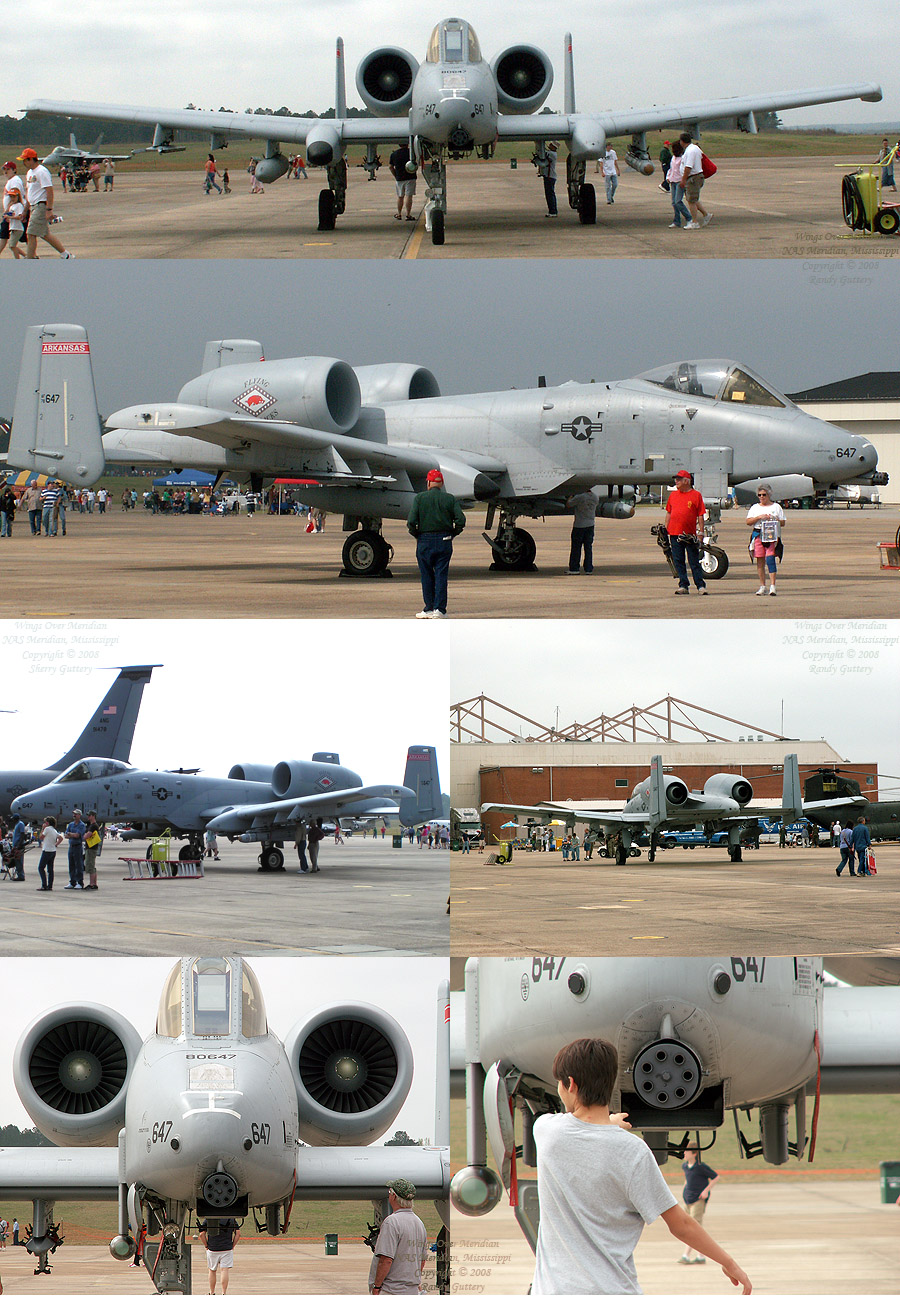 |
|||||||
| A-10 Warthog. Ugly, Slow- and incredibly lethal. OK - technically - it's "official" name is "Thunderbolt"... but most people call it Warthog - or even just "Hog". This is the Air Force's bastard child - and they in fact - tried to "give it away" to the US Army - twice. Most of the high command in the Air Force was in love with the high performance F-15 and F-16s - and saw the need for close support a role that the Army themselves should take care of - After all - the AH-64 Apache helicopter equipped with the AGM-114 Hellfire anti-armor missile can take out a tank with ease. The problem is, however - in close support - helicopters become dangerously susceptible to ground fire and simple anti-air craft weapons. The A-10 was designed based on Hans-Ulrich Rudel's book, "Stuka Pilot". Rudel had flown an out-dated air plane - with crudely adapted 37mm guns during WWII - yet despite this unlikely contraption - his record of destroying Russian Tanks was most impressive. He credited in no small part the contribution of his plane's ability to not only survive ground attacks - but continue to press his attack with little impairment from hits to his own plane. Taking cues from his success - and using modern air frame technology, great engines from GE - and a cannon that is awesome in it's own right - the Warthog has proven to be an asset the Air Force has reluctantly come to love. The high mounted General Electric TF34-GE-100 turbofan engines are up away from "FOD" allowing the A-10 to operate from runways and fields that would likely damage under wing mounted engines - their 6:1 by-pass ratio means they have a very low heat signature (making it much harder for heat seekers to target); they a quieter than most high performance jet engines - making them harder to locate. The hard points allow mounting a large array of weapons - including Mavericks and Sidewinders. But the real terror - is that 30 mm GAU-8/A Avenger Gatling gun. Firing an incredible 3900 depleted uranium armor-piercing shells per minute - any target is thoroughly pummelled. A typical 2 second burst from an A-10 in a 30 degree dive will deliver approximate 100 hits to a tank-sized target. The optimum "firing" distance is 4000 feet - so the A-10 can deliver this punishment from nearly a mile away - though since the gun is on the plane's center line - and aligned with the crafts fore-aft axis - if the pilot lines up on a target - and fires as he closes - he's going to shred whatever the target is. During the 1991 Gulf War - when the A-10 saw combat for the first time - A-10s destroyed 1000 Iraqi tanks, 2000 military vehicles, 1200 artillery pieces, and a couple of Iraqi helicopters. The A-10s were particularly effective in eastern Iraq where the oil-well fire smoke made high-level bombing and other attacks very difficult for more traditional fighters and bombers. A-10 were able to descend through the smoke - find their targets and dispatch them with great efficiency. The 30 mm Avenger Gun was particularly useful in strafing Iraqi forces trying to execute Hussein's "scorched-earth" orders. | |||||||
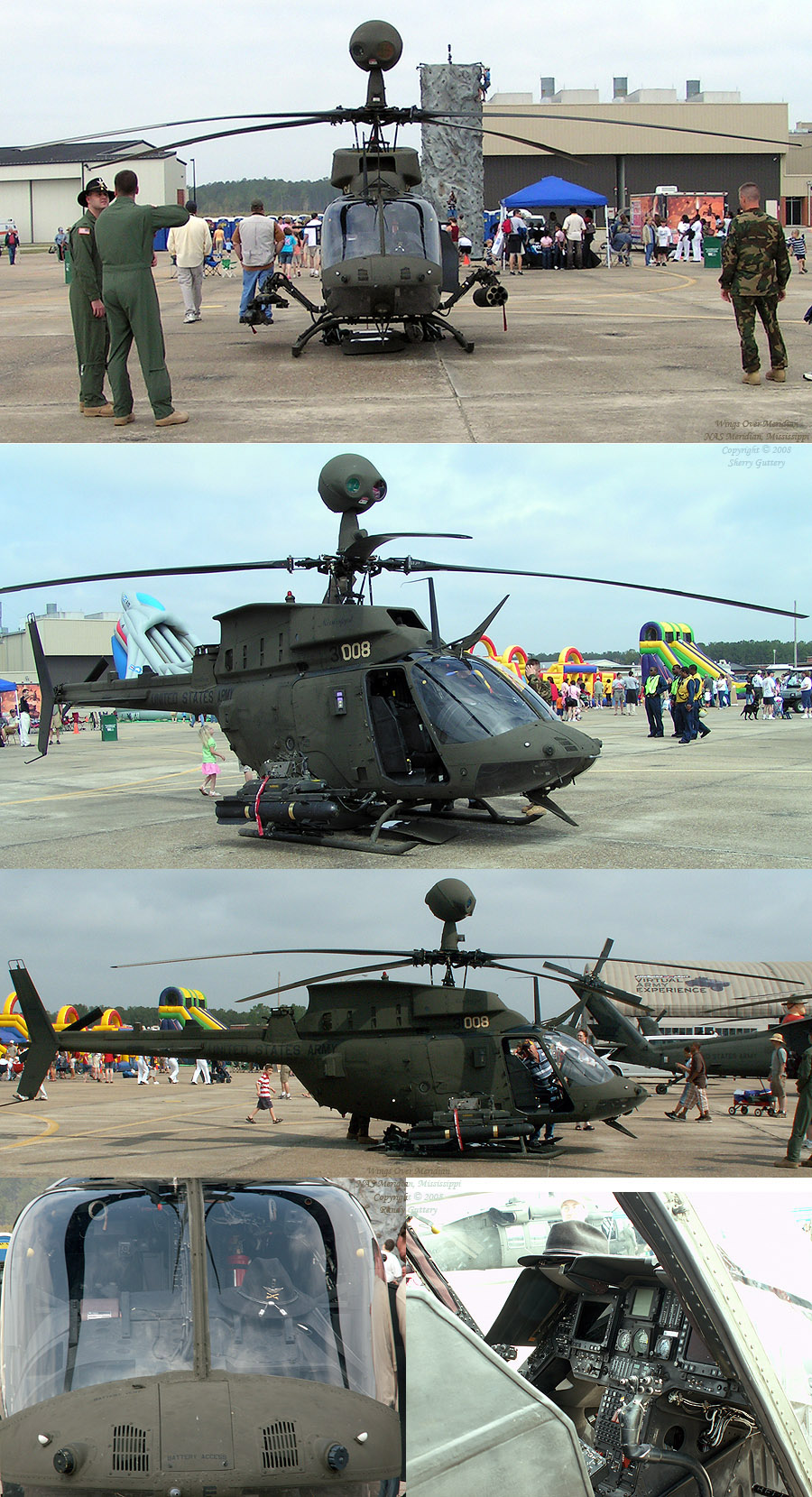 |
|||||||
| In Mississippi - even the Army can fly. This is the OH-58D Kiowa Warrior built by Bell Textron. The OH-58D's primary role is as an armed Observation and Reconnaissance Air Craft. In earlier times - the OH-58Ds often worked as a team with an AH-1 Cobra. However - with the AH-1 now replaced by the AH-64 Apache - the need for the OH-58s as observer/spotter has been greatly reduced. The "Warrior" version of the D model added weapons mount hard-points outboard of both sides of the craft - allowing the Kiowa to become a light attack helicopter when the opportunity was favorable. The mounts can support a variety of systems including the Hellfire missile. OH-58s have been in service since 1969 - with the D upgraded versions flying since 1988 - but they're still flying on Viet Nam era airframes - so the Army is replacing the OH-58Ds with the ARH-70 Armed Reconnaissance Helicopter. It will be several years, however before production can replace all of the deployed ships - so in the meantime - they keep flying. This Warrior is flown by the 185th Company "H" out of Tupelo, Mississippi. Bit of trivia about helicopters and Mississippi - the U.S. Army's LU-72 "Lakota" Light Utility Helicopter is made in Columbus, MS. The LU-72 is replacing the A through C versions of the OH-58s and the Blackhawk helicopter in various roles. Mississippi? Believe it! |
|||||||
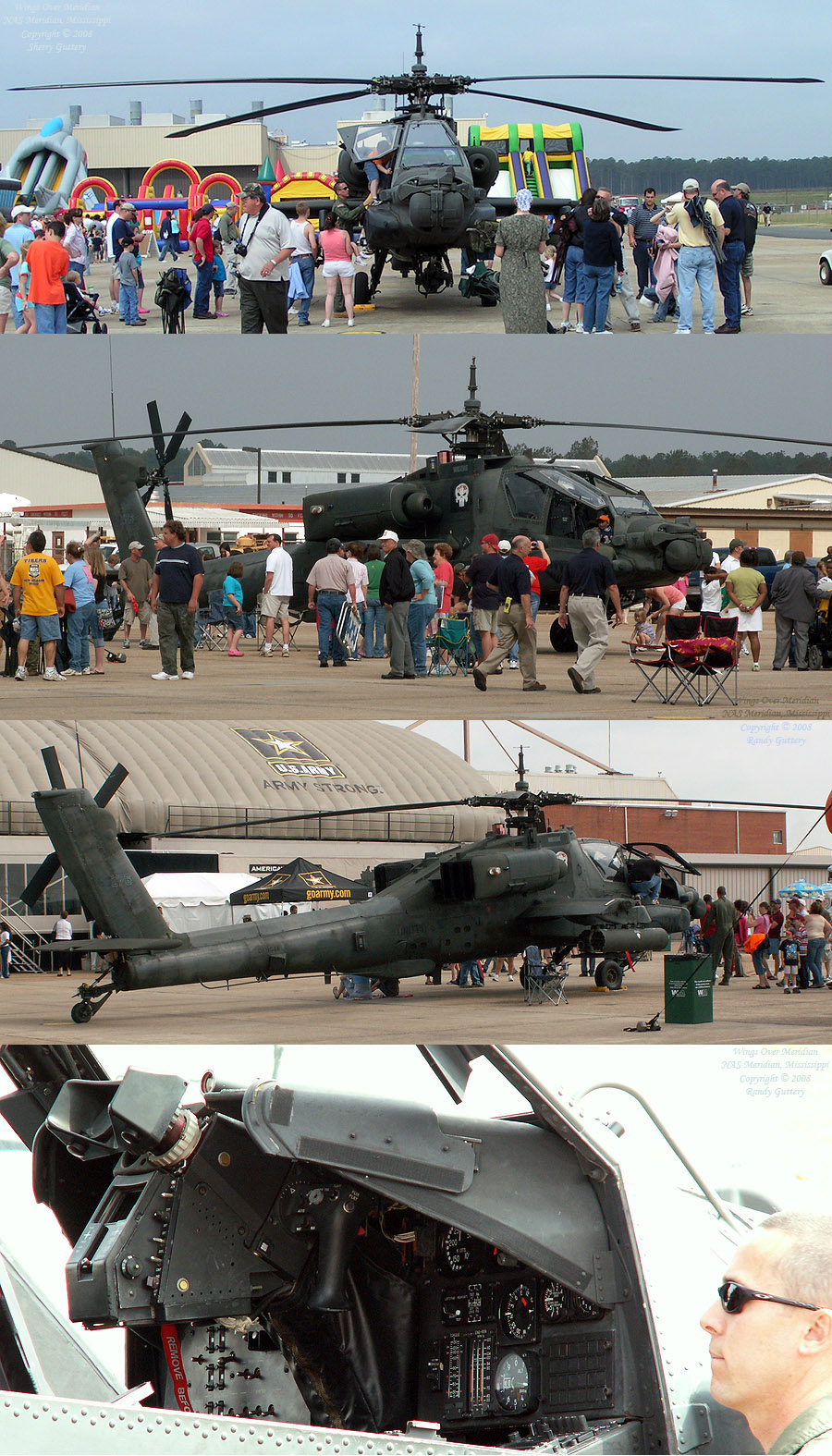 |
|||||||
| Speaking of the AH-64 Apache - they are flown by Troops D, E and F of the 1-104th CAV out of Tupelo, Mississippi. The Apache is the result of the Army's desire for a more effective tank killer - and during operation Desert Storm - they proved they had achieved that goal. Only the A-10 Warthog destroyed more tanks than the Apaches during Dessert Storm. | |||||||
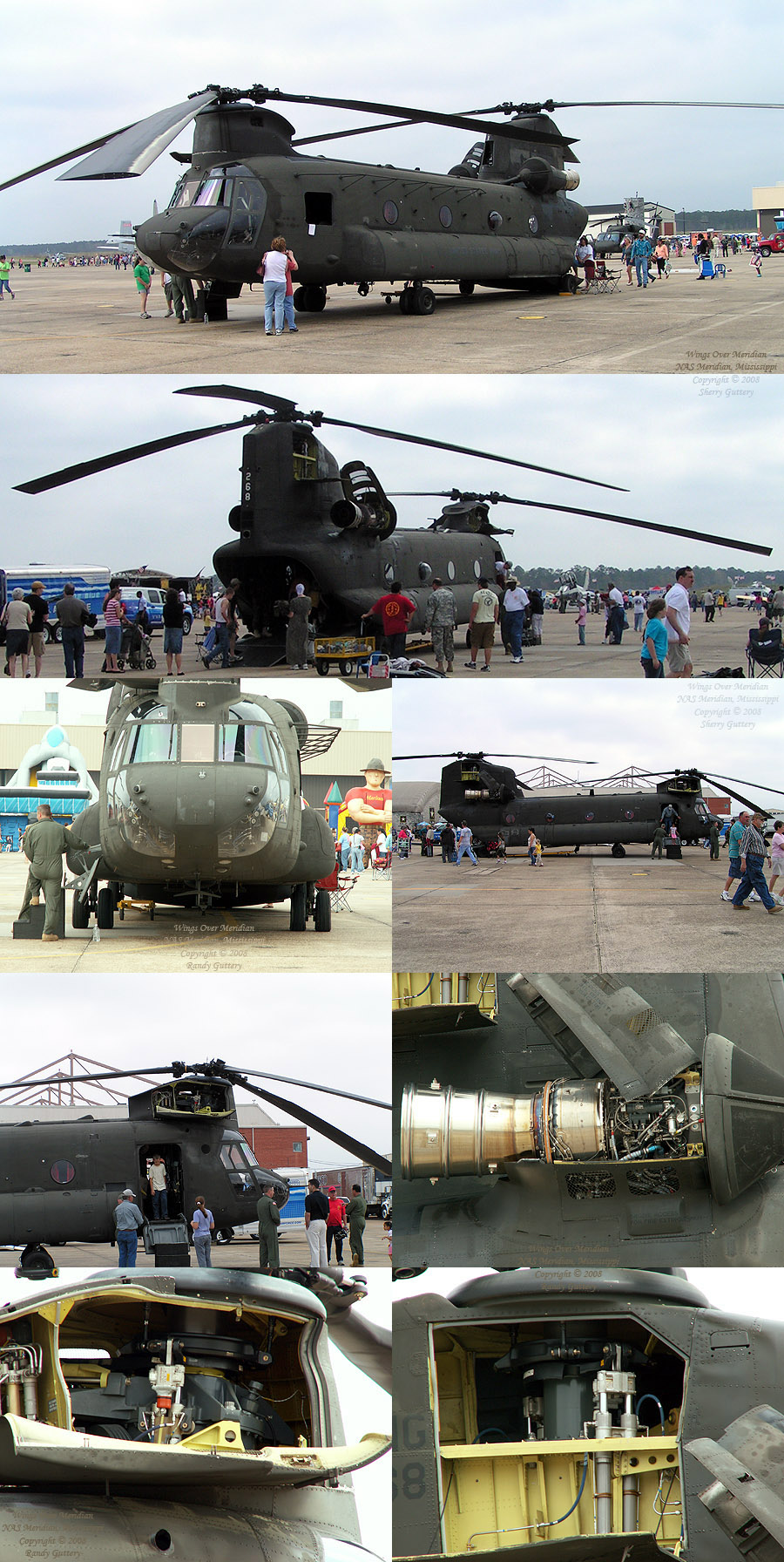 |
|||||||
| On the main page of Glimpses of Meridian we mentioned that Key Field was a very active military base as well as regional air port. One of the commands at Key Field is the Army National Guard's 185th Army Aviation Support Facility, Company G. - who operates a fleet of CH-47 Chinook medium lift helicopters. Yup - like the KC-135R - these park just four miles from our front door. For many years - Company G flew the famous CH-54 Sky Cranes - which was an incredible machine. And noisy. An shook the house when they flew over. But they were impressive with the amount of "stuff" they could get from here to there. In 1992, the Sky Cranes were replaced by twin-rotor CH-47 Chinook medium lift helicopters. While the Chinook is "called" a "medium lift" helicopter - the newer versions with their upgraded engines and transmissions are actually capable of 28,000 pounds of cargo vs. the 20,000 pounds of the Sky Crane. And unless they're doing some really odd approach very low - we seldom see or hear them - and the house doesn't shake near as often (and more often than not - any house shake is Kansas City Southern or Norfolk Southern playing "bumper cars" switching freight on the tracks 2 blocks north). While not capable of the awesome loads of the C-17 Globemaster III - these can land an take off any place with enough room to clear the rotors... There are a few "stories" around about trimming branches every so often - though we suspect those might be embellished a bit... One thing that isn't embellished - is the ability of Company G to transport large numbers of troops, their equipment and supplies - anywhere they need to go. | |||||||
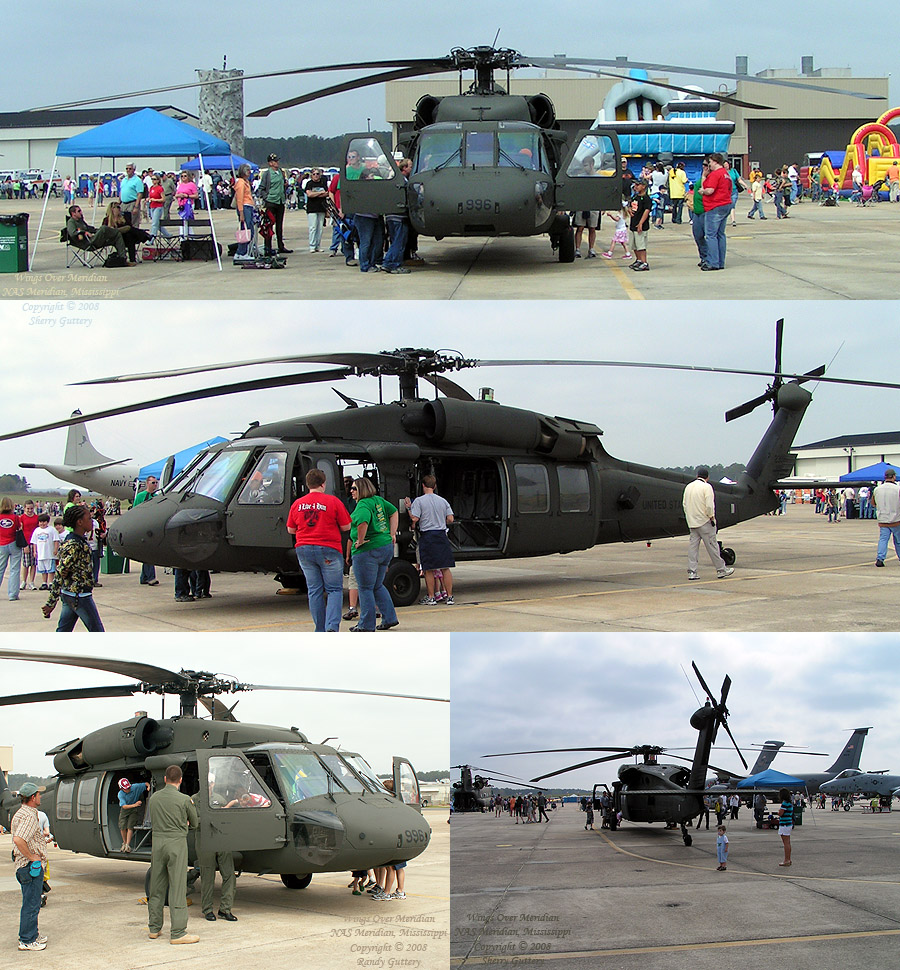 |
|||||||
| UH-60A Black Hawk flown by the 185th Companies C and D out of Jackson and Tupelo, Mississippi. | |||||||
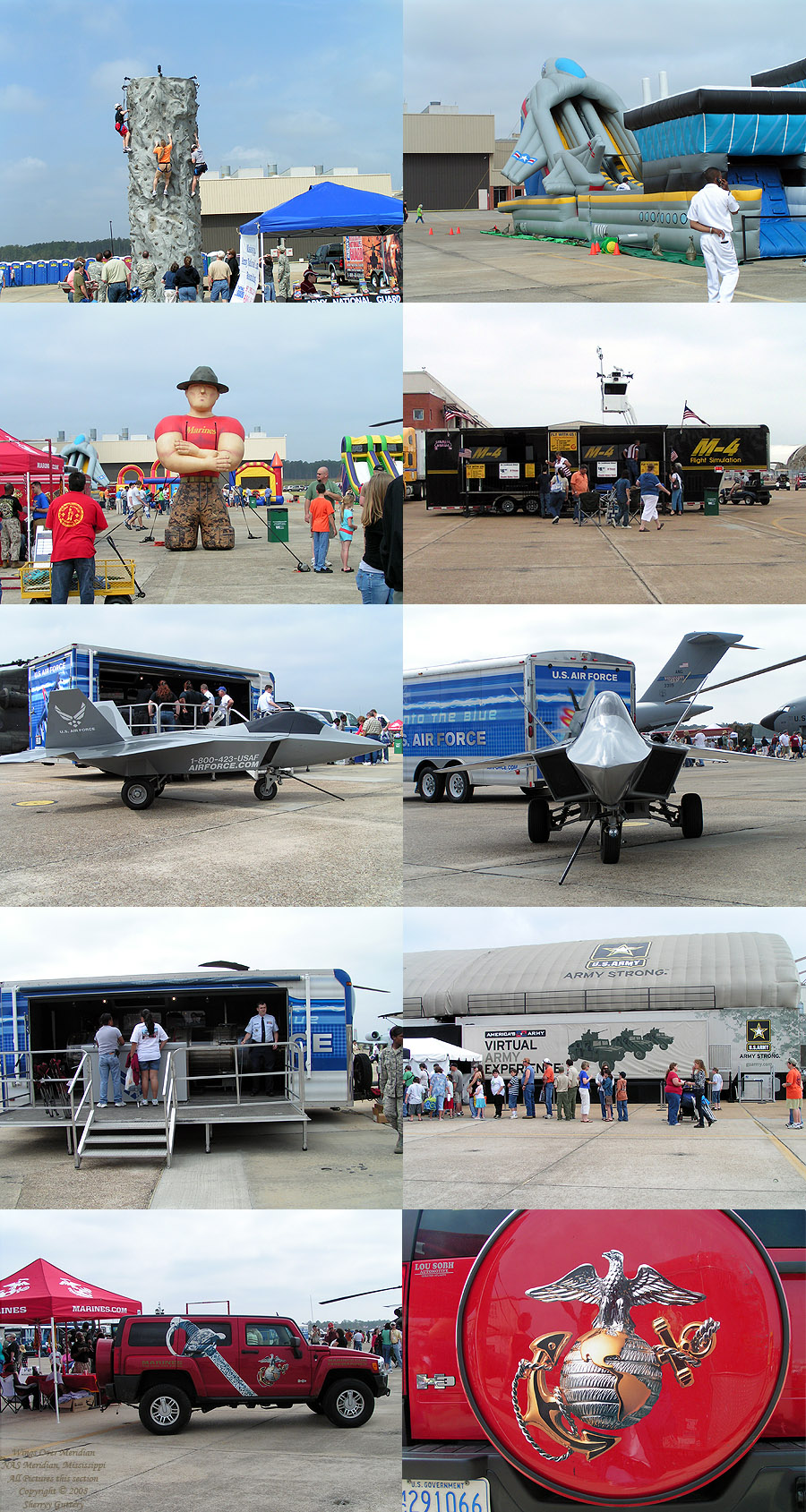 |
|||||||
| Things to see and do: For the "older" kids - a "rock wall" to climb (sponsored by the National Guard), and for "younger" kids - an Air Craft Carrier slide; A mighty "Devil Dog" Marine, a Fighter Simulator that could (and would) tumble you as fast as you cared to "push it"; F-22 "Raptor" model; Jet Engine display, U.S. Army's "Virtual Experience"; the U.S. Marines' information booth and H3 "Hummer" vehicle. |
|||||||
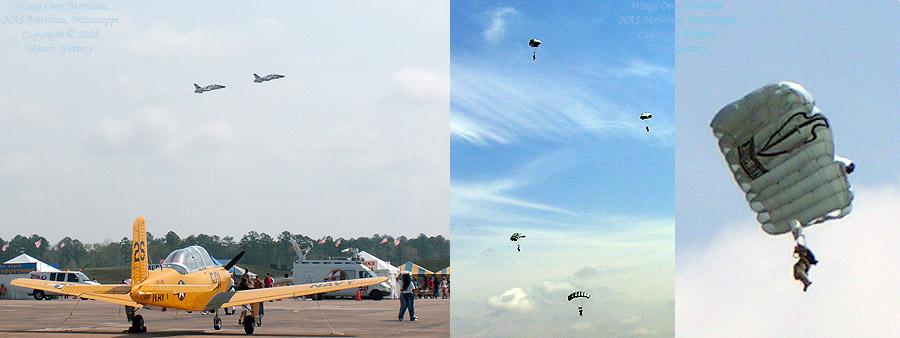 |
|||||||
|
|||||||
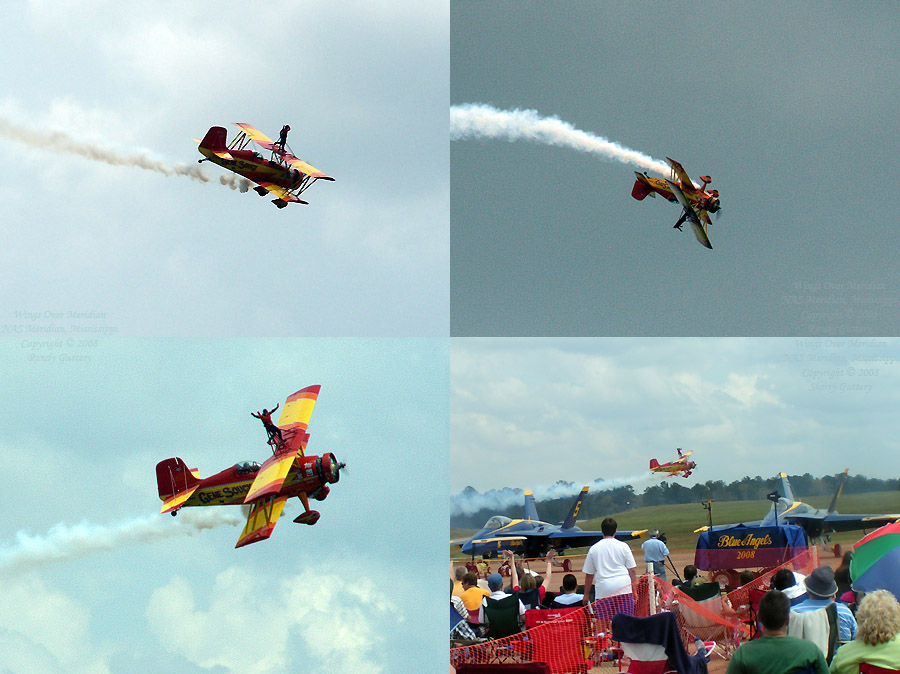 |
|||||||
| Gene Soucy and Teresa Stokes put on quite a show - with a most impressive wing walking exhibition - and stunts that have a rich history in the old "barn storming" days. This is Teresa's 20th year wing-walking on Gene's wings... | |||||||
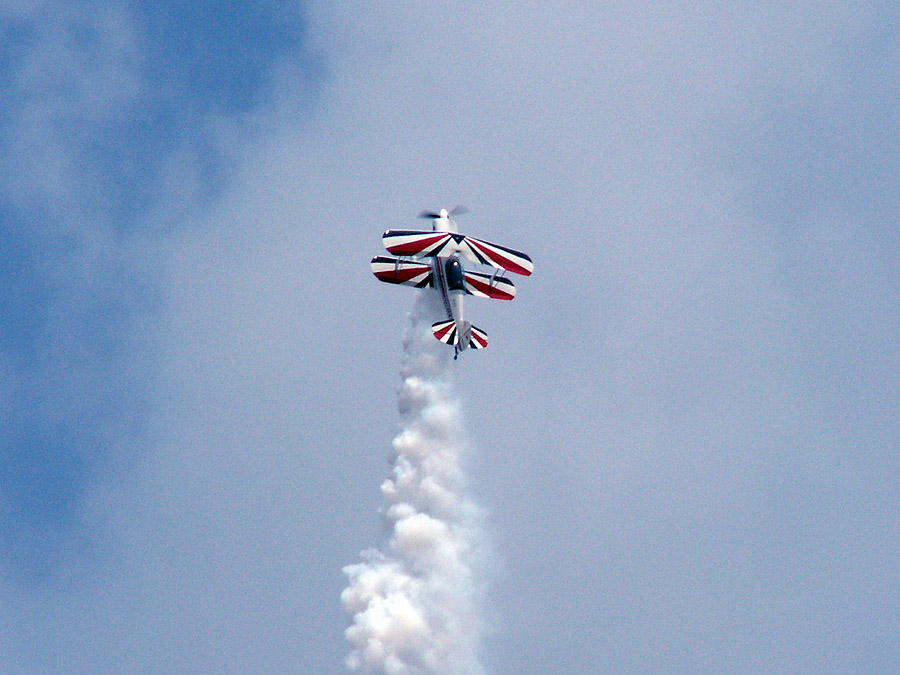 |
|||||||
| Ken “K9” Appezzato (from Columbus, MS) pushes his Vortex Eagle right to the limits as he nears the top of a "Hammerhead" stall. | |||||||
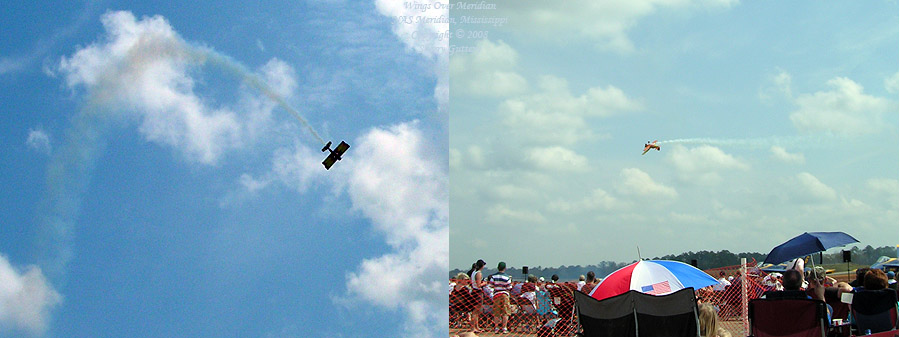 |
|||||||
| Gene Soucy also took a turn solo performing some amazing stunts. | |||||||
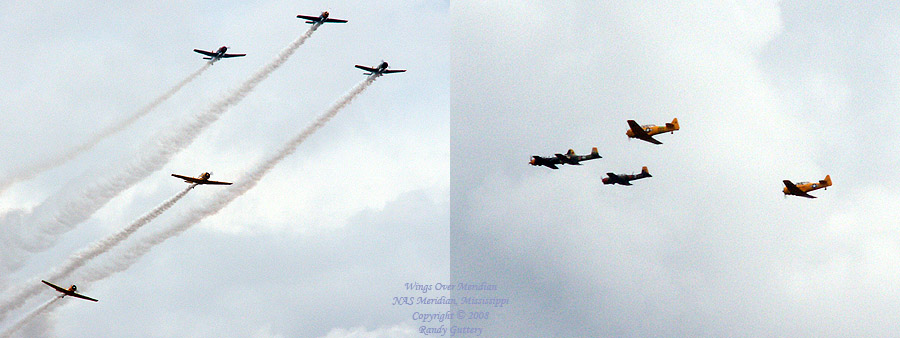 |
|||||||
| The show featured many war-birds from years gone by - all of which made important contributions to this country's defense. | |||||||
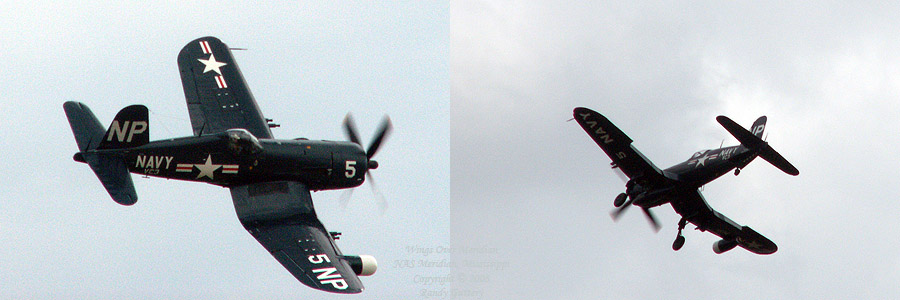 |
|||||||
| One of the more famous is the F4 Corsair. This plane is an F4U-5NL Corsair equipped with both the 154 Gallon drop tank and the very rare Intercept RADAR unit (visible near the end of the right wing) . These planes have an unmistakable appearance due to the "bent wing" design which helps extend the landing gear down long enough to clear that huge (13ft.) propeller. | |||||||
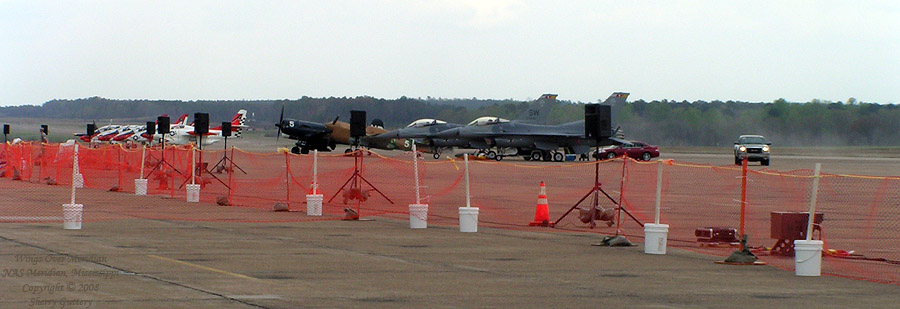 |
|||||||
| The flight-line with several Goshawks, the Corsair (one unidentified craft) and two F-16 Falcons | |||||||
 |
|||||||
| "Fat Albert" - the Blue Angels' C-130 Hercules Transport puts on a show. This is the only Marine Corps aircraft permanently assigned to support a Navy squadron. It is flown by an all-Marine Corps crew of three pilots and five enlisted personnel. Fat Albert flies more than 140,000 miles during the course of a show season. | |||||||
 |
|||||||
| Blue Angels FA-18 Hornet - plane #1 | |||||||
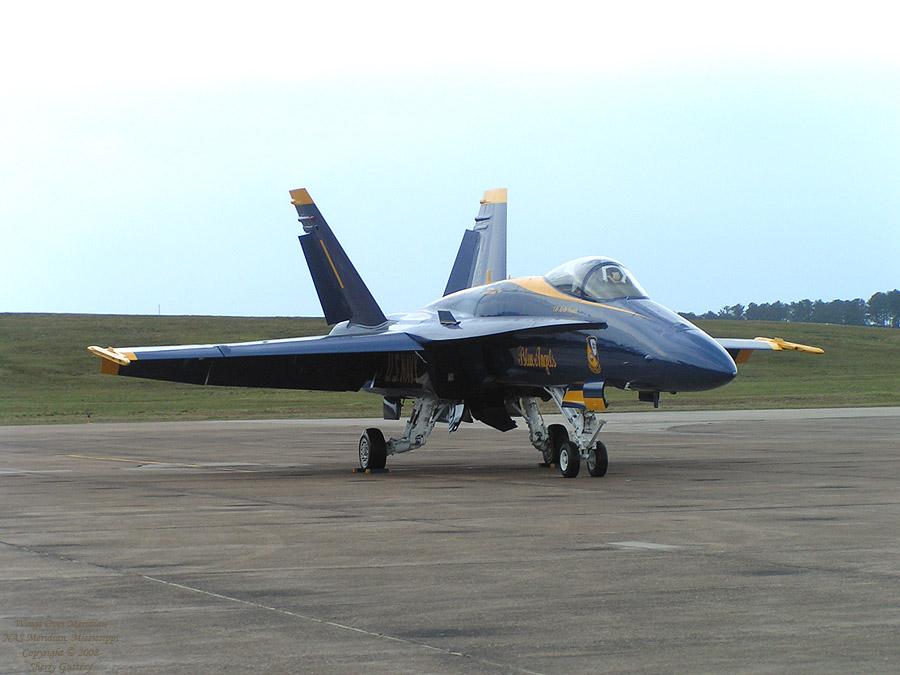 |
|||||||
| FA-18 has become the workhorse of the U.S. Navy with the recent retirement of the F-14 Tomcat. The Hornet is capable of Mach 1.8, service ceiling of 50,000 feet, and a combat range of some 1275 nautical miles. During some missions in Operation Desert Storm - Hornets shot down enemy fighters - then proceeded on to bomb their targets - all in one flight. Not many planes are capable of serving both fighter and bomber roles at the same time. | |||||||
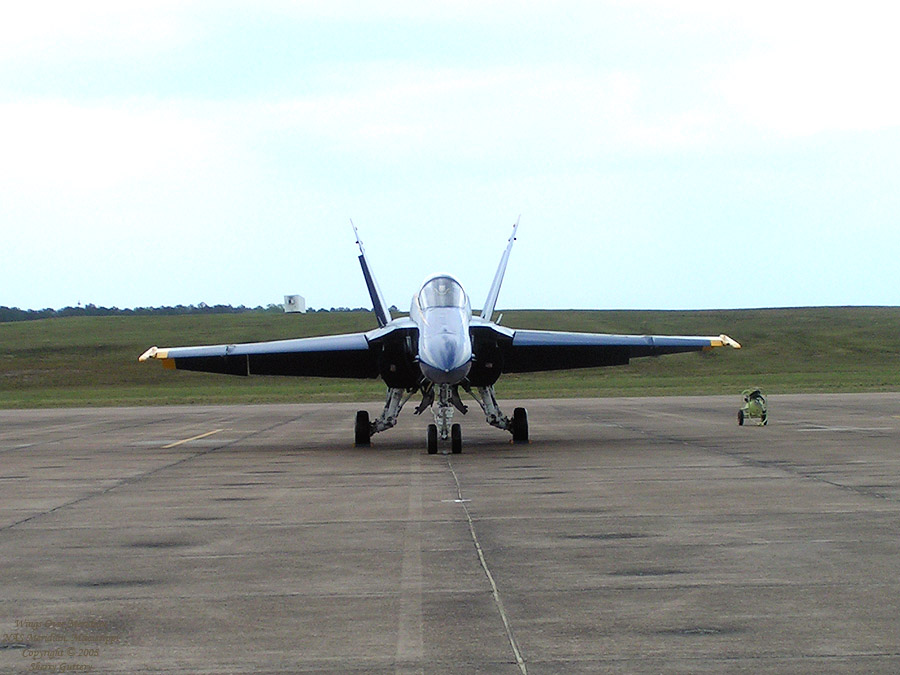 |
|||||||
| Nose to nose with Blue Angels' Plane #2. | |||||||
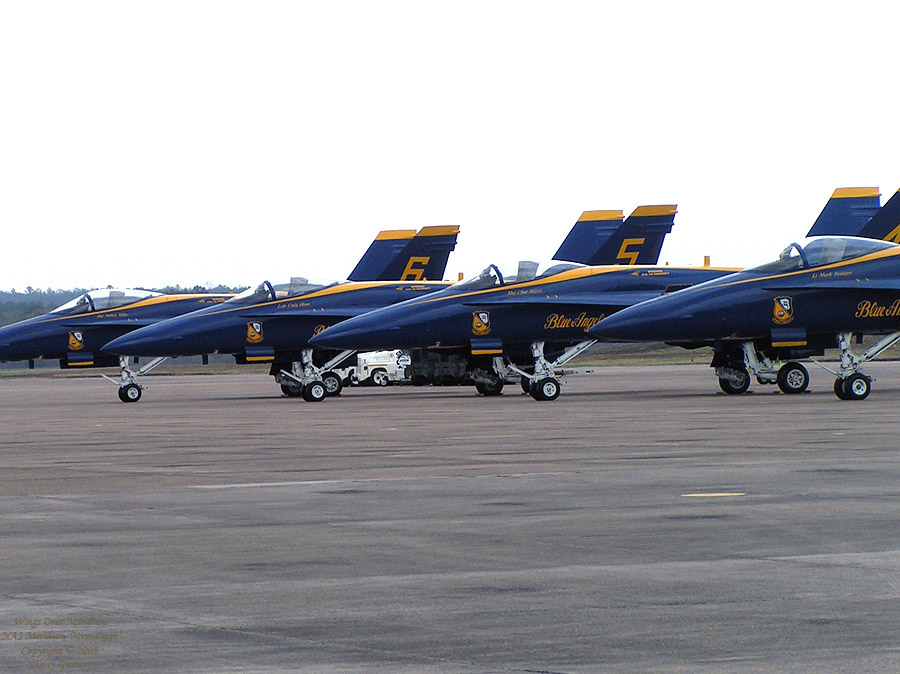 |
|||||||
| Blue Angels Planes 3-6 ready to fly. | |||||||
 |
|||||||
| Blue Angels load up and put on a show. Even though it rained - they still did not disappoint the crowd. | |||||||
|
|
|||||||
|
|||||||
|
|
|||||||
| Email: Randy and Sherry Guttery - Comcents.com | |||||||
|
|
|||||||
| Glimpses of Meridian, Mississippi | |||||||
Visitors:
    |
|||||||
| Unless otherwise noted - contents of this site are copyright © 2008 Common Cents Computers. All rights reserved |
